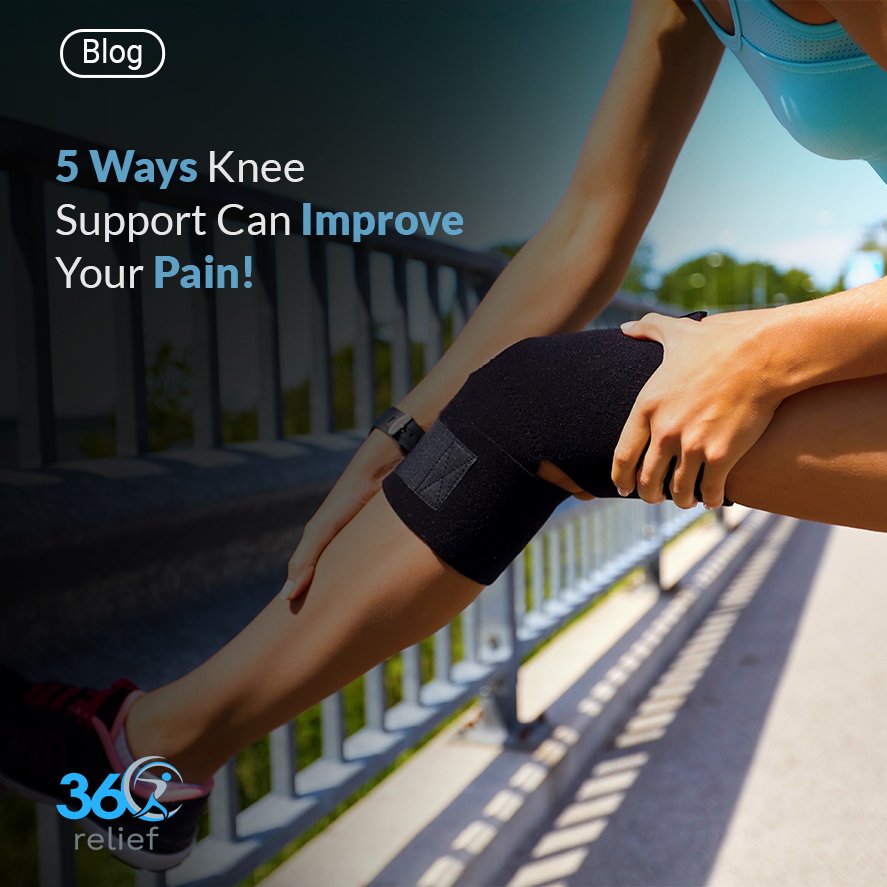
Make This Christmas Pain-Free: 10% Off on Supportive Wear!
Holidays are coming, which means that let’s welcome them with joy, laughter, and, of course, some comfort! At 360 Relief,

Do you have a painful knee problem that takes you to physiotherapy…for an injury that hampers your daily living…your workout routine…or sporting activities?
Well, you’re not alone…
But the good news is that knee bracing combined with good physiotherapy exercises can help to lessen the degree of your pain and make it easier for you to start moving again.
Physicians and physical therapists commonly suggest knee bracing due to its effectiveness in addressing various knee issues. Getting knee braces is relatively easy and unobtrusive… but when do they even benefit?
Read on and know what kind of knee brace you can use and how it can benefit you.
Table of Contents
ToggleAh, that’s an interesting question and, frankly, one I get asked more often than you might imagine.
You can wear a knee brace if you’re looking to:
Knee bracing does help to decrease pain because it offers more support and immobilisation to that joint. A hinged knee brace may make you comfortable or relieve you of some worry. It can give a ‘swayless’ injured knee, the stability it needs when walking.
An improvement to the design is the use of a hinged knee brace with the use of plastic parts to support the knee when it is more acute or painful. This is the type of knee bracing I usually advise my physiotherapy patients to use because it offers them adequate support to continue with their activities in comfort and with pain as much as possible.r peace of mind, It can help a “wobbly” injured knee feel more stable when you walk.
Knee braces with hinges and plastic supports provide added support for acute or painful injuries. My physiotherapy patients often choose this type of knee bracing because it provides them with the support they need to keep moving.
On the other hand, if you feel pain below or around the kneecap, the function of the patellofemoral braces is to immobilise the kneecap to reduce the weight that lies directly on the kneecap.
It’s for this reason that if you use this type of brace in conjunction with certain physiotherapy exercises, your kneecap should track better and you shouldn’t feel this pain.
In case your major issue is swelling, you will find that a compression knee bandage is ideal because it applies great pressure on the tissues around the knee to minimise swelling.
Some of the patients I have talked to really love this type of brace because it gives them more confidence in their knees. It helps their knee that is why – and it is also comfortable – to walk with them.
They are produced from a lightweight, air-permeable fabric, which is excellent for wearing for all kinds of day-to-day actions and sports.
Because people are living longer today, we’re seeing everyone from young adults ⚣ in their 40s or 50s getting knee pains from osteoarthritis from wear and tear from an active lifestyle, their job or daily activities.
Unloader braces work by taking your weight off the damaged area of your joint to relieve pain from osteoarthritis and decrease the knee pain from the bones rubbing directly against each other.
Instead, more recent research indicates that unloader knee braces and physiotherapy exercises decrease knee pain, increase activity and function, and may prevent surgery.
If you have an ACL tear or ligament injury, this Adjustable neoprene Knee support enhances stability in an unstable knee and lessens pain. They assist in maintaining the stability of the knee joint and prevent pulling off of the knee ligaments to versions such as lateral or medial, side to side or forward-backwards motion. A couple of remarkable reports of studies have pointed out how knee bracing may also reduce your risk of additional injury or subsequent deterioration.
If you are settling back into the sport of your choice then you will need braces that can offer dynamic support and assist in the protection of the knee for/with sports that involve movement in any sharp angle or contact.
Naturally, it should be understood that patellar tendon knee support can only be performed to a certain extent.
Flexibility and strength do come in handy especially when it comes to minimising knee problems…But I do wish to stress that a knee brace helps ensure that you do not sit out your daily life in favour of the couch while you build up your strength.
No matter if you are suffering from ligament injury, meniscus tear or because of the bone on bone osteoarthritis the message that you get here is..
It’s possible to continue putting pressure on your knee even with a brace on…still, do not forget your physiotherapy if possible and keep your leg muscular!
Well, now all of that has been said what next…Which type of knee brace will suit you?
Always remember…always have to make out the type of brace you need, one has to decide what problem the brace will solve.
So…first, ask yourself this…
“Is my main problem pain? Swelling? Instability? Arthritis?
It’s simple, right?
Yes, hopefully, it is…but don’t worry if it seems like a lot to take in at any of the stages. But let me tell you, There are literally lots of types of knee bracing out there and, you may also be struggling with more than one issue.

Holidays are coming, which means that let’s welcome them with joy, laughter, and, of course, some comfort! At 360 Relief,

Happy Cyber Monday to everyone; it is a perfect occasion for 360 Relief to offer a special discount of 10%

This Black Friday, take advantage of exclusive 10% savings on some of 360 Relief’s best-selling compression socks and support braces!

Everyday life includes walking up stairs, but knee discomfort can make this basic activity difficult. Walking up or down stairs

Cooking is a beloved activity for many, but for those struggling with knee pain, standing in the kitchen can quickly

We’ve all been there. On a ride in a car, for instance, to the country home for a weekend break

Gardening is enjoyable for many people and those who like tending to their lawns and plants usually find it therapeutic

Training can be very much associated with some pains and injuries that may be experienced by the trainers. As there

Office workers often spend hours seated at their desks, focusing on tasks while unknowingly putting their health at risk. The

Winter often brings more than just a change in weather; for many, it also means dealing with unexpected swelling in

Compression socks have become a critical tool for athletes across all sports. Whether you’re a marathon runner, cyclist, or weightlifter,

October marks the beginning of National Cholesterol Month in the UK, a time dedicated to raising awareness about cholesterol and

Overall, there is nothing to match the experience of watching musicians perform live in an outdoor concert in Glastonbury. However,

Today charity runs have gained popularity as a way of raising cash for a cause in the United Kingdom. From

Top 360 Relief Items for a Pain-Free Olympic Experience in Paris 2024 The Olympic Games are the most unique sporting
Please enter your email to subscribe to our newsletter for exclusive offers and updates
Copyright © 2025 | 360 Relief Ltd | Sitemap

